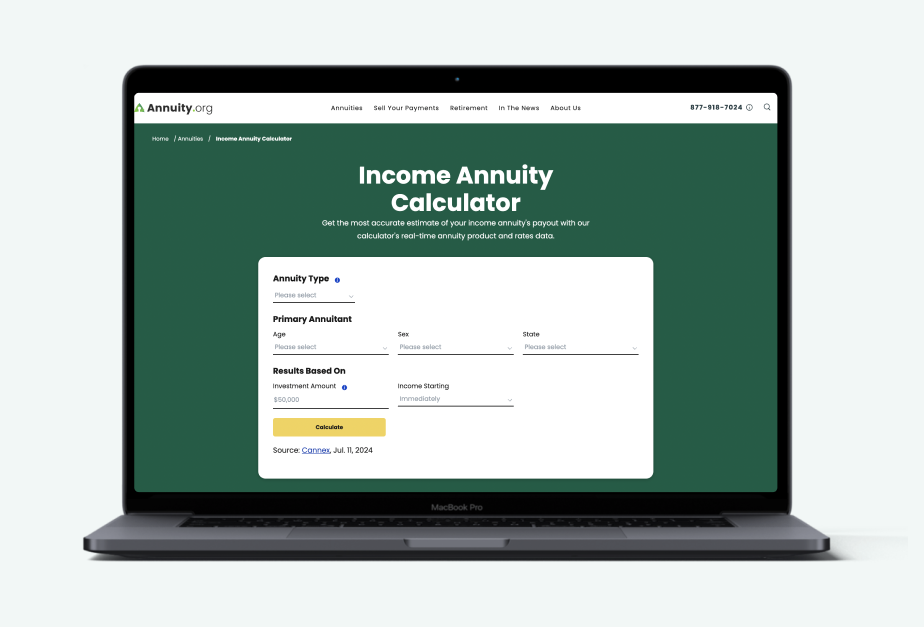Annuities pay out based on several factors when you start income (immediate or deferred) and how long payments last (for a set period, your lifetime, or both spouses’ lifetimes). Common options include period certain, single life, life with period certain, joint & survivor, lump sum, and systematic withdrawal. Your monthly amount depends on factors like age, sex, premium size, payout type, and insurer rates. Many contracts also include a death benefit for beneficiaries.
When Payments Start
When it comes to creating reliable retirement income, timing matters. Some people may want an immediate annuity that provides predictable distributions right away for living expenses, while others may prefer a deferred annuity that allows their money to grow before they access it later. These two common options each offer unique advantages depending on your goals, timeline and risk tolerance.
Immediate Annuity (SPIA)
Enjoy income right away
- Start
- Within 12 months
- Best for
- Retirees seeking dependable income right away
- You get
- Predictable checks for a set period or your lifetime
- Considerations
- Less time for growth; payments locked in at purchase
Deferred Annuity
Begin at retirement for larger future payments
- Start
- Years later typically at retirement
- Best for
- Savers who want tax-deferred growth before income
- You get
- Greater potential for larger future payments
- Considerations
- Market/crediting method; contract fees vary by product
How Long Payments Last
Annuities allow you to choose how long income lasts, whether it is for a fixed period, your lifetime or both you and your spouse’s lifetime. Each type of annuity balances monthly payout size with the level of protection you want for heirs.
Period Certain
Best for income lasting a fixed period (e.g., bridge to Social Security/RMDs).
More on Period Certain →
Single Life (Life Only)
Best for maximizing lifetime income without survivor benefits.
More on Single Life →
Life with Period Certain
Best for lifetime income with a minimum guarantee to protect heirs.
More on Life with Period Certain →
Joint & Survivor
Best for income to continue for surviving spouses.
More on Joint & Survivor →
Lump Sum
Best for full, immediate access to funds but with potential tax impact.
Systematic Withdrawal
Best for flexible payout amounts and timing and accept the risk of depleting funds.
Adding guarantees or a survivor reduces each payment but increases protection.
How Payouts Are Calculated
Every annuity payout is calculated based on your personal details, including these key factors.
- Start date: The later you begin your payments, the fewer distributions there are, thus providing a higher distribution amount.
- Life expectancy: Due to their longer life expectancy, women typically receive slightly lower payments.
- Investment size: The more you invest, the higher your monthly payouts will be, but be sure to compare the best annuity rates to maximize your distributions.
- Payout option: Life-only annuities pay more than life-with-guarantees or joint options.
Understanding these drivers makes it easier to compare options, allowing you to better understand how even small changes can affect your retirement income.
John vs. Mary — How Timing and Options Affect Payments
Assume John, 70, and Mary, 65, each invest $100,000 into a single premium immediate annuity.
| John | Mary | |
| Investment | $100,000 | $100,000 |
| Age | 70 | 65 |
| Payout | Life-Only | Joint-and-survivor payout |
| Life expectancy | Shorter | Longer |
| Estimated payout | $650/month | $520/month |
Takeaway: John maximizes his own income, while Mary accepts a smaller monthly amount to ensure her husband’s financial security if she passes first. This trade-off shows how age, sex, premium size, and payout type work together to shape annuity income.
This trade-off shows how age, sex, premium size, and payout type work together to shape annuity income.
Death Benefit
Annuities aren’t just about the income you receive during your lifetime. Many contracts also outline what happens afterward.
If you want to leave money behind for your spouse or heirs, an annuity death benefit determines how and when your beneficiaries will receive those funds. Understanding the differences between qualified and non-qualified annuities can help you set clear expectations and avoid surprises for your loved ones.
How Death Benefits Are Paid
- Qualified annuities: Beneficiaries generally must withdraw the full value within 10 years of the annuitants death.
- Nonqualified annuities: Options may include a lump sum distribution, which is subjective to the five-year rule, or withdrawals based on life expectancy.
- Annuities with no named beneficiary : Proceeds may be awarded to the estate.
How Carol Used a Death Benefit
Carol, age 62, purchased a deferred annuity to supplement her retirement income. Her biggest concern wasn’t just steady income for herself but rather, ensuring her two children are still supported if she passes away early.
To accomplish this, she chooses a life annuity with a 10-year period certain payout. This guarantees her lifetime income and also ensures that if she dies before the 10- year period her children will receive the remaining payments.
Takeaway: Adding a death benefit or period-certain feature may reduce your monthly payout, but it has the benefit of creating lasting financial protection for your loved ones. This trade-off reflects a common priority among retirees who don’t want their family to face financial uncertainty after they are gone.
Choosing how an annuity pays out is one of the most important retirement decisions you’ll make. This will determine not only when income begins but also how long it lasts and whether your spouse and heirs are protected after you die.
Some people prioritize the largest possible monthly check, while others prefer the peace of mind that comes with survivor benefits or guaranteed minimum payout periods.
There is no single best choice for annuity, only the one that best suits your age, health, financial needs, and family goals.
That’s why it’s so important to take time to run the numbers, compare scenarios and discuss the trade-offs with financial advisor. A professional can help you weigh higher income today against longer-term security, so you can ensure that your annuity payout aligns with your broader retirement plan.
Annuities come with various payout options and as I sell my clients an annuity, I always discuss the various ways an annuity pays out. Guiding my clients on the front end helps them make an informed decision and helps me, as an agent, decide the best product for them. People buy annuities to satisfy their retirement goals, so when to get a payout from their annuity is an important aspect I discuss with them at sale time and at policy reviews.
Use the Annuity.org Calculator to determine what kind of pay you can expect so you can choose the best annuity for your retirement years.






